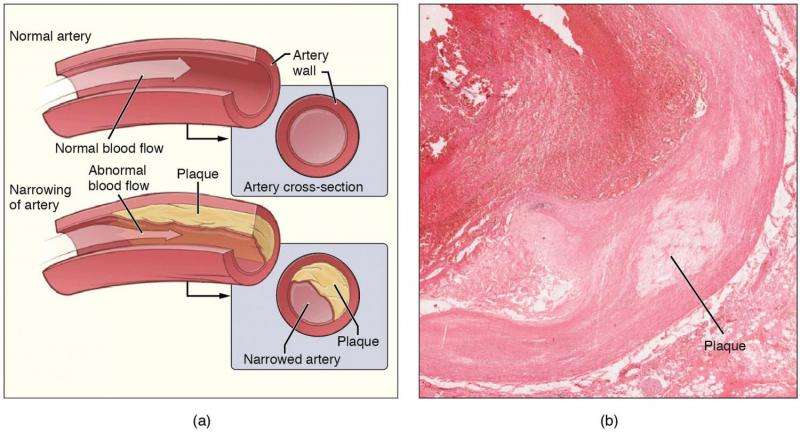This article has been reviewed according to Science X's editorial process and policies. Editors have highlighted the following attributes while ensuring the content's credibility:
fact-checked
trusted source
proofread
Managing your risk of carotid artery disease

Carotid artery disease occurs when the blood vessels supplying your brain and head, known as carotid arteries, are damaged or blocked by fatty deposits. These deposits contain cholesterol that organizes as a plaque, which clogs or blocks the carotid arteries. This is similar to coronary artery disease, which reduces blood flow to your heart.
This blockage in blood vessels increases your risk of stroke—a medical emergency that occurs when the blood supply to the brain is interrupted or seriously reduced. When a stroke occurs, oxygen can't reach the brain, and brain cells begin to die within minutes.
Usually, carotid artery disease develops slowly. The first sign that you have the disease may be a stroke or transient ischemic attack, or TIA, a temporary decrease of blood flow to your brain.
Who is at risk for carotid artery disease?
Your risk of developing carotid artery disease increases if you have a family history of the disease or atherosclerosis. Age also is a risk factor. As you age, your arteries become less flexible and are more easily damaged.
Other risk factors for carotid artery disease include:
- Diabetes
- High blood-fat levels
- High blood pressure
- Lack of exercise
- Obesity
- Sleep apnea
- Tobacco use
What are treatments for carotid artery disease?
Preventing a stroke is the primary goal of treating carotid artery disease. A treatment plan will be based on the degree of blockage in your carotid arteries and could include a combination of lifestyle modifications, medications and surgery.
Treatment for mild to moderate blockages may include lifestyle changes to slow the progression of damage to your arteries, including quitting smoking, losing weight, reducing salt intake and exercising regularly. Medication to control blood pressure, lower cholesterol or prevent blood clots also may be recommended.
Your care team may recommend removing the blockage from the artery if it is causing severe narrowing or if you have already had a stroke or TIA.
There are different options to remove the blockage from the carotid artery:
Carotid endarterectomy
This is the most common treatment for carotid artery disease and involves cutting along the front of the neck to open the carotid artery. The blood flow is temporarily stopped while removing the plaque causing the clog or blockage. At the end of the procedure, the artery is closed with a patch made from a vein, an artificial material or the lining of a cow's heart.
Carotid stenting
There are two types of carotid stenting: transcarotid and transfemoral.
Transcarotid artery revascularization, or TCAR, is a minimally invasive procedure that treats carotid artery disease and helps prevent strokes. During the procedure, a small incision is made just above the collarbone to access the carotid artery. A tube or catheter is placed into the artery and connected to a transcarotid neuro-protection system, or NPS. This system diverts blood flow through a filter or basket that catches and prevents loose plaque or debris from entering the brain. After the plaque and debris are collected by the device filter, the blood is returned to a vessel in the leg. Then a wireless mesh tube, called a stent, is inserted to stabilize the blockage site and normal blood flow is resumed.
Transfemoral carotid stenting is considered when carotid endarterectomy or transcarotid stenting is not feasible. A tube or catheter is inserted in the groin. A wire and catheter are navigated to the carotid artery's diseased section. A filter or basket placed just beyond the blockage catches plaque or debris that becomes loose during the procedure before entering the brain. A stent is inserted to stabilize the blockage site, and the filter is removed at the end of the procedure. Transfemoral carotid stenting carries a risk of stroke during the procedure that is twice as high as carotid endarterectomy or transcarotid stenting.
Are there ways to reduce the risk of developing carotid artery disease?
To prevent or slow the progression of carotid artery disease, take these steps to manage your risk factors:
- Control chronic conditions. Manage any chronic conditions, such as diabetes and high blood pressure.
- Consider limiting your salt intake. Reducing sodium can help lower your risk of developing high blood pressure.
- Eat a variety of fruits and vegetables. Healthy foods provide valuable nutrients for your body, which may protect you from a stroke.
- Exercise regularly. Being physically active can improve the health of your blood vessels and heart.
- Limit cholesterol and fat intake. This may help reduce the accumulation of plaque in your arteries.
- Limit your alcohol intake. Drinking alcohol in excess increases your risk for carotid artery disease.
- Maintain a healthy weight. Maintaining a healthy weight reduces your risk of developing high blood pressure, diabetes and other health risks.
- Quit smoking or don't start. After just a few years, a nonsmoker's and a former smoker's risk of stroke are comparable.
Next steps:
- Request an appointment with a vascular medicine specialist.
- Learn about peripheral artery disease—another type of arterial disease.
- Discover how genetic testing gives insight into cardiac conditions.



















